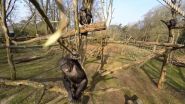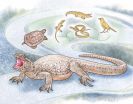(Press-News.org) CAMBRIDGE, Mass. (September 3, 2015) - In the breast, cancer stem cells and normal stem cells can arise from different cell types but tap into distinct yet related stem cell programs, according to Whitehead Institute researchers. The differences between these stem cell programs may be significant enough to be exploited by future therapeutics.
Deadly tumor-initiating cells seed metastases throughout the body and cause relapses in patients. Whether these tumor-initiating cells can also be referred to as stem cells, specifically, cancer stem cells, has been up for debate. The question is not purely one of semantics--the label connotes scientists' understanding of those cells' identity and inner workings.
"Our research establishes for the first time the relationship between the normal stem cell program and the cancer stem cell program, albeit in the context of the mammary gland," says Whitehead Institute Founding Member Robert Weinberg. "There may be slight variations on this theme in other epithelial tissues, but at least the relationship is firmly secured in the context of the mammary gland, which seems to be a pretty good model for other epithelial tissues. Tumor-initiating cells are in fact cancer stem cells, but cancer stem cells do not arise from normal stem cells."
The Weinberg lab's findings are described in this week's issue of the journal Nature.
Previous work in the lab has demonstrated that cancer stem cells emerge after undergoing an epithelial-to-mesenchymal transition (EMT), which endows the cells with the motility and flexibility required for seeding new tumors. The EMT may also confer on the cells the ability to resist standard chemotherapeutics.
In the current line of research, Xin Ye, who is a senior research associate in the Weinberg lab and the lead author of the Nature paper, used a mouse model that shows which cells within the normal and cancerous mammary gland express the related master regulators Snail and Slug, both of which confer stem-like traits on mammary cells. Slug, for its part, is especially potent in inducing the "mesenchymal" cell traits that are associated with high-grade, aggressive carcinomas.
Ye determined that different cell types in distinct tissue layers within the mammary gland express and are influenced by these master regulators. Slug, which regulates gland-reconstituting activity in breast tissue, is expressed at higher levels in normal stem cells found in the 'basal layer" of mammary ducts. Snail, a factor first discovered in the context fruit fly embryonic development, is expressed by tumor-initiating cells in the luminal layer of cells in these ducts. Snail has the power to confer aggressive traits on cancer cells that Slug is incapable of doing when it is expressed at normal levels.
"Snail-positive cancer stem cells arise in a different population of cells than the cells that harbor normal stem cells," says Weinberg, who is also a professor of biology at Massachusetts Institute of Technology and Director of the MIT/Ludwig Center for Molecular Oncology. "Normal stem cells reside in one layer in the mammary duct; cancer stem cells arise in another. What that means is that cancer stem cells do not arise from normal stem cells. This has been a point of much discussion, but now there is evidence--finally!"
Such basic insights about the source of cancer stem cells and the differences between normal and cancer cells could provide leads for new cancer therapeutics.
"We're starting to realize that a lot of things are regulated differentially in normal versus cancer settings," says Ye. "It doesn't even need to be cancer stem cell versus normal stem cell--cancer versus normal is really different. If we understand the differences better, we have a better chance of treating this disease."
INFORMATION:
This work was supported by the National Research Foundation, Singapore (NRFNRFF2015-04), American Cancer Society, Ludwig Foundation, Breast Cancer Research Foundation, National Cancer Institute Program (P01-CA080111, U01-CA184897, R01-CA078461, K99-CA194160), Samuel Waxman Cancer Research Foundation, Mattina R. Proctor Foundation, Helen Hay Whitney Foundation, and Andria and Paul Heafy.
Robert Weinberg's primary affiliation is with Whitehead Institute for Biomedical Research, where his laboratory is located and all his research is conducted. He is also a Professor of Biology at Massachusetts Institute of Technology and Director of the MIT/Ludwig Center for Molecular Oncology.
Full Citation:
"Distinct EMT programs control normal mammary stem cells and tumour-initiating cells"
Nature, online September 2, 2015.
Xin Ye (1), Wai Leong Tam (1, 2, 3), Tsukasa Shibue (1), Yasemin Kaygusuz (1), Ferenc Reinhardt (1), Elinor Eaton (1), Robert A. Weinberg (1, 4, 5).
1. Whitehead Institute for Biomedical Research, Cambridge, MA 02142, USA??
2. Genome Institute of Singapore, 60 Biopolis Street Singapore 138672, Singapore
3. Cancer Science Institute of Singapore, 14 Medical Drive, Singapore
4. Department of Biology, Massachusetts Institute of Technology, Cambridge, MA 02139, USA??
5. Ludwig Center for Molecular Oncology, Massachusetts Institute of Technology, Cambridge, MA 02139, USA??
A brief series of classes to help first-time parents better support each other through the often stressful transition to parenthood has a positive effect on birth outcomes as well, according to health researchers.
A decade ago Mark Feinberg, research professor at the Bennett Pierce Prevention Research Center for the Promotion of Human Development, Penn State, developed Family Foundations, a series of classes for expectant parents. In two research trials, the program was shown to improve the way parents support each other -- to reduce parental stress, depression and anxiety; ...
AUSTIN, Texas -- Evidence from the tropical lowlands of Central America reveals how Maya activity more than 2,000 years ago not only contributed to the decline of their environment but continues to influence today's environmental conditions, according to researchers at The University of Texas at Austin.
Synthesizing old and new data, researchers were the first to show the full extent of the "Mayacene" as a microcosm of the early anthropocene -- a period when human activity began greatly affecting environmental conditions.
"Most popular sources talk about the anthropocene ...
In some patients, aggressive cancers can become resistant to chemotherapy and radiation treatments. In a paper published in the journal Nature Communications, University of California, San Diego School of Medicine researchers identified a pathway that causes the resistance and a new therapeutic drug that targets this pathway.
"It was previously known that RAF (a family of proteins that regulate cellular signaling) governs resistance to therapies. We discovered an undescribed role for RAF and learned precisely how it occurs in a broad range of cancers," said lead author ...
PHILADELPHIA -- Acupuncture may be a viable treatment for women experiencing hot flashes as a result of estrogen-targeting therapies to treat breast cancer, according to a new study from researchers at the Perelman School of Medicine at the University of Pennsylvania. Hot flashes are particularly severe and frequent in breast cancer survivors, but current FDA-approved remedies for these unpleasant episodes, such as hormone replacement therapies are off-limits to breast cancer survivors because they include estrogen. The results of the study are published this week in the ...
Montreal, September 3, 2015 -- Sleep matters for kids, especially when they are stressed. A new study led by researchers Jinshia Ly, Jennifer J. McGrath and Jean-Philippe Gouin from Concordia University's Centre for Clinical Research in Health and the PERFORM Centre shows that poor sleep might explain how stress impacts health in kids.
A good night's sleep
Getting a good night's sleep might buffer the impact of stress on kids' cortisol level, which is a hormone produced in the adrenal gland to regulate the body's cardiovascular, metabolic and immune systems. While short-term ...
Cool. Calm. And oh, so calculated. That's how a chimpanzee living in the Royal Burgers' Zoo in the Netherlands set out to swat an aerial drone that was filming her group. In an article in the journal Primates published by Springer, Jan van Hooff and Bas Lukkenaar explain it as yet another example of chimpanzees' make-do attitude to using whatever is on hand as tools.
The incident happened earlier this year, on 10 April, when a Dutch television crew was filming at the zoo in Arnhem. The idea was to use a drone to film the chimpanzees in their compound from different close-up ...
Amsterdam, September 3, 2015 - 3D imaging of a mummified kestrel that died due to forced overeating provides evidence that the ancient Egyptians bred birds of prey as offerings for the gods, according to a new study published in the Journal of Archaeological Science. The digital CT imaging revealed that the kestrel was force-fed its last meal - a mouse - suggesting it was kept in captivity.
This is the first evidence to point to mass breeding of raptors as offerings to gods. The researchers behind the study, from the American University in Cairo, Stellenbosch University ...
Amsterdam, September 3, 2015 - Elsevier, a world-leading provider of scientific, technical and medical information products and services, has announced that its Reviewer Recognition platform has launched a new functionality which enables reviewers to list their entire review history, including their reviews for non-Elsevier journals, in one place online. It also allows them to share their Reviewer Page publically - increasing visibility and recognition of their work.
Through the Reviewer Recognition platform, Elsevier reviewers already have access to a personal review ...
A 260-million-year-old fossil species found in South Africa's Karoo Basin continues to provide information into the murky origins of turtles whose evolution fascinates scientists.
The fossil of an extinct reptile, named Eunotosaurus africanus, is the earliest known branch of the turtle tree of life.
"Eunotosaurus is a critical link connecting modern turtles to their evolutionary past," says Dr Gaberiel Bever an Honorary Research Associate at Wits University's Evolutionary Studies Institute (ESI) and scientist at the New York Institute of Technology.
Previous studies ...
UK fisheries survey logbooks from the 1930s to 1950s have been digitised for the first time, revealing how cod responded to changing temperatures in the last century.
Scientists at the Centre for Environment, Fisheries and Aquaculture Science (Cefas) and the University of Exeter found that at the time, the warm seas experienced around Norway benefitted the cod, similar to the conditions there today.
Most cod eaten by the UK comes from northern seas including the Barents Sea around Norway, because the stocks there at the moment are at record highs. Cod stocks were also ...

